December 31, 2013 - Colorado
The White-tailed Ptarmigan is one of the most beautiful and distinctive birds in North America in its pristine snow-white winter plumage, and also one of the most difficult to see. Accessing the preferred habitat of this species in winter takes some work. Guanella Pass was once considered the best place to find them in winter, but that changed in 2006 when Clear Creek County decided to stop plowing the road that leads over the pass.
Despite now being described as "strictly a summer destination" due to the lack of plowing, I decided to attempt a trip up to Guanella Pass earlier this month in search of the ptarmigans. Doing so required renting a Jeep for several miles of driving on unplowed roads above 10,000 feet, followed by a few miles of hiking through the snow. Wind and a lack of recent snowfall had allowed a firm crust to develop on the snowpack, so I didn't use the snowshoes I'd brought, but sporadic soft spots caused me to fall through the crust, sinking hip-deep on occasion. Despite being a bit of a fitness freak, carrying my photo gear up to the pass at 11,670 feet proved challenging for this lowlander. But that was only the start of the challenge; several more miles of hiking were required as I criss-crossed the area in search of ptarmigans.
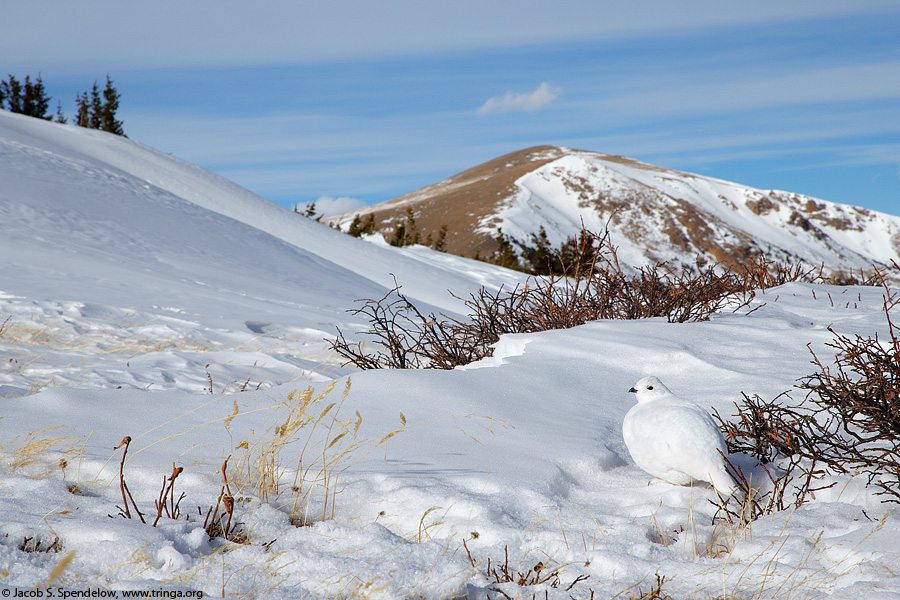
A White-tailed Ptarmigan in its snowy winter habitat.
The snow-white plumage of the White-tailed Ptarmigan makes it an exceptionally difficult bird to find in winter, and I consider myself lucky to have found a flock after only a few hours of hiking. By that time the sun was high and the light was harsh, but I stayed with the birds all afternoon and was able to get a few photos as the light improved.
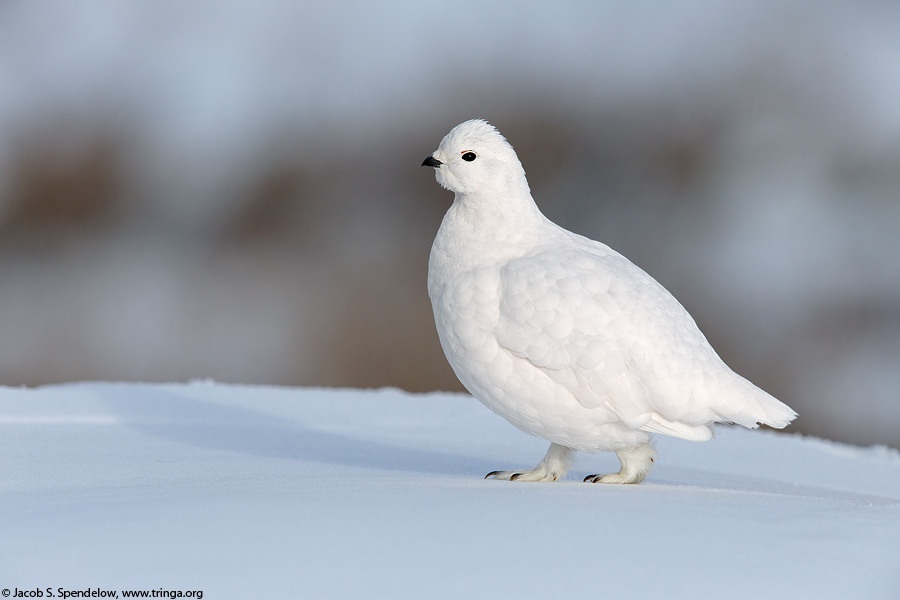
No other bird in North America has such pristine white plumage as the White-tailed Ptarmigan.
I stayed past sunset so that I would know where the birds were spending the night, then hiked back down to my car to camp for the night. Relatively mild temperatures made it possible to sleep out under the stars that night, but I was awoken a few hours before sunrise by snowflakes falling on my face. By the time I got up there was almost an inch of snow on my sleeping bag, and it kept falling in light flurries all morning. Hiking back up to the pass before sunrise, I was dismayed to find that the ptarmigans were no longer where I had left them the night before. And so I set off again on another lengthy search of the area, again not finding them until almost noon. It was worth all the effort, though, to get photos of the beautiful ptarmigans wading through the snow, with snowflakes falling all around them.
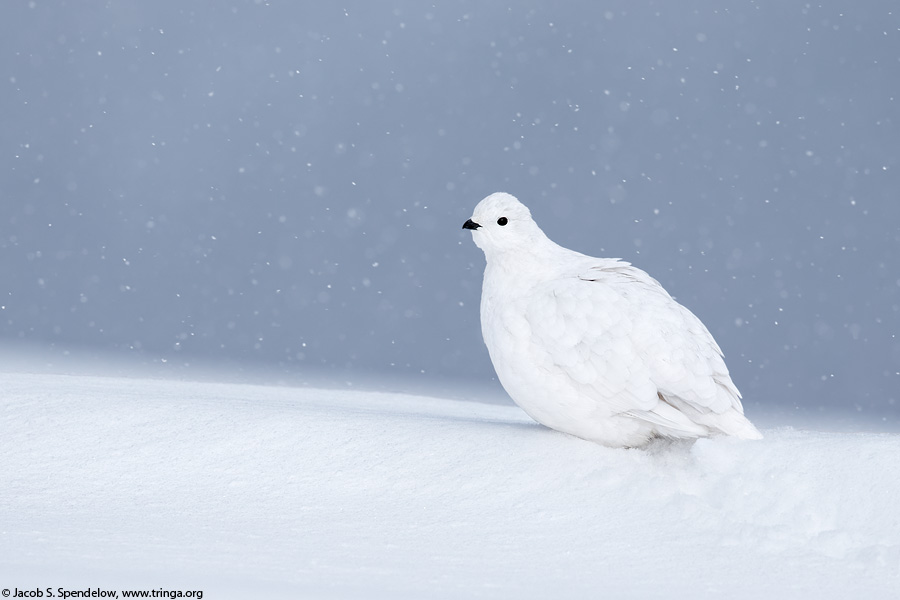
After a mostly sunny first day on Guanella Pass, I was lucky to have a change in weather overnight, allowing me to get photos of ptarmigans in the falling snow on the second day.
After an exhausting two days of ptarmigan trekking, I was ready for something less grueling, so I did some camera-less birding north of Denver in the morning before heading up to Rocky Mountain National Park in the afternoon. I found only a few birds to photograph in the park, but was more interested in the opportunities for mammal photography. The rutting season was largely over by the time of my visit, but I still got to see plenty of Elk, as well as some Mule Deer. With a flight to catch the next morning, I could only stay for the afternoon, but it's certainly an area that would be worth spending more time in on a future trip.
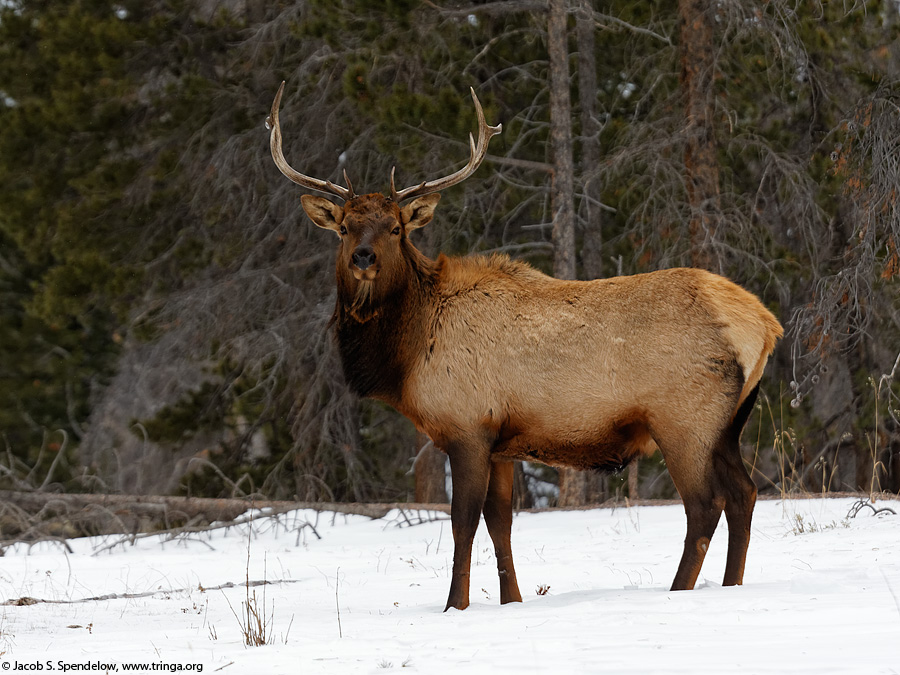
A member of a small herd of elk I found moving through the forest in Rocky Mountain National Park.
September 13, 2013 - Spring Road Trip
I spent most of this spring in the Southwest, photographing as much as possible and adding 49 new bird species to my files. Leaving Virginia in early April, I spent a couple mornings photographing in Texas, then continued on to New Mexico, which was my home base for over two months. It was great to be back in Los Alamos again after almost four years away. I headed out almost every morning for a pre-work photo session, and fit in a few in the evenings as well, in the process photographing several species that had eluded me earlier.
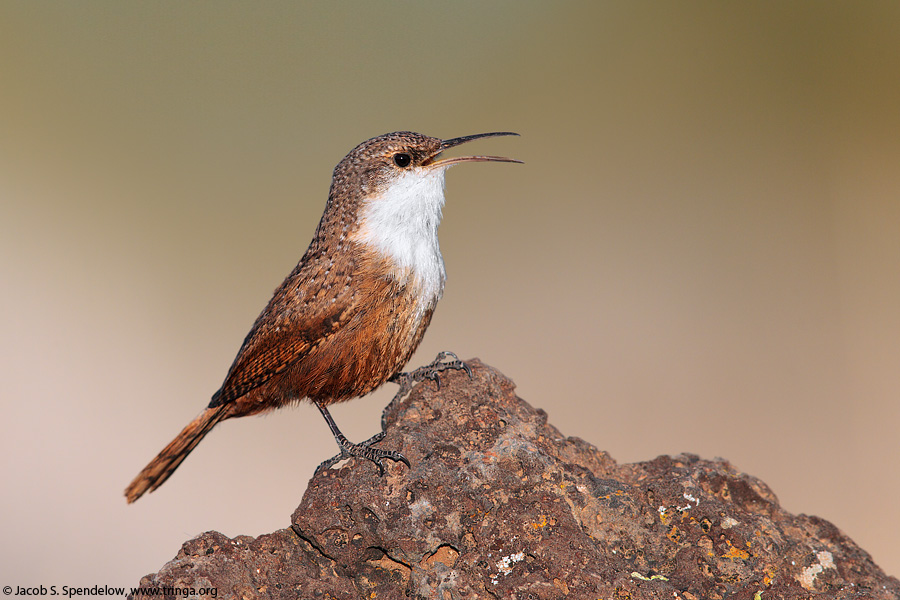
A Canyon Wren sings on the rim of White Rock Canyon.
The highlight of my southwestern trip was a three week stint in Southeast Arizona, one of the best birding areas in North America and an area I hadn't photographed seriously prior to this trip. The wide variety of habitats supports a diverse avifauna, including many species more typical of Mexico than the United States. My list of target species was ambitious, but I'd been planning and researching for this trip for years, so I knew exactly where to look for most of my targets.
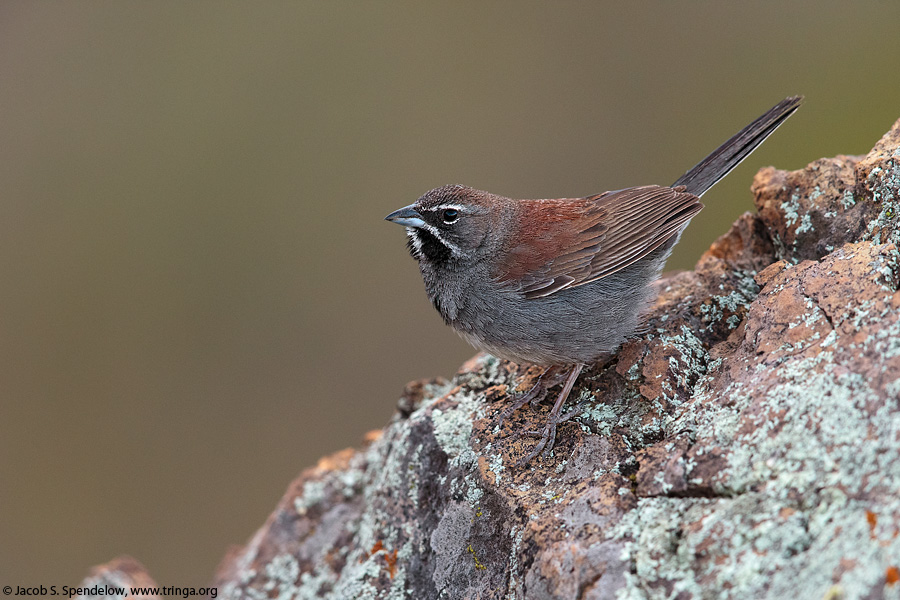
A Southeast Arizona specialty, Five-striped Sparrows are highly local, breeding in just a few locations close to the Mexican border. This individual was photographed in California Gulch.
The trip had its ups and downs, including plenty of heartbreaking near misses, but the nice thing about a long trip is that you can fail repeatedly and still find success in the end. By the end of the trip, I'd photographed almost all of the common and uncommon species, with Olive Warbler being the only really painful miss. I was especially happy to photograph all of the common flycatchers of the southwest - I added 14 new species of flycatchers alone on this trip.
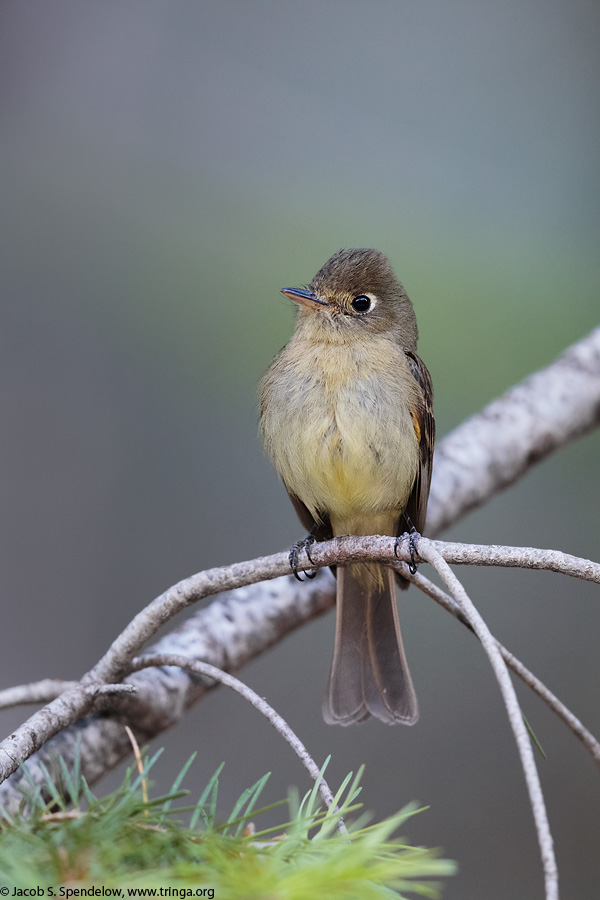
Cordilleran Flycatchers breed in the higher parts of the Madrean Sky Islands. This individual was photographed at around 8000 feet elevation on Mt. Lemmon.
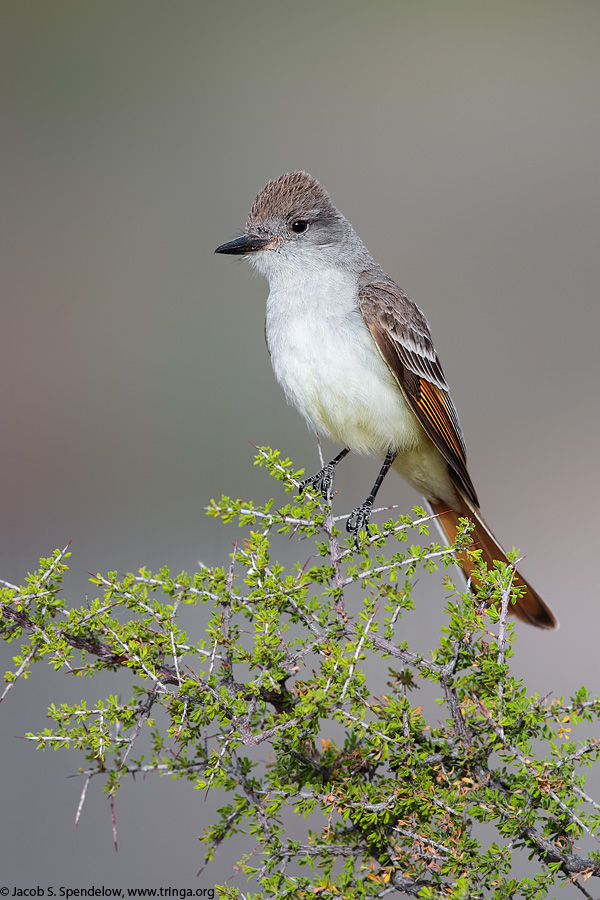
The Ash-throated is one of three quite similar Myiarchus flycatchers inhabiting Southeast Arizona. It is readily distinguished by voice. Silent birds can be identified by the rusty undertail, relatively pale yellow underparts, and relatively small bill.
Flycatchers, being mostly rather drab, don't elicit much interest from any but the most hardcore birders, but the Southwest also has its share of stunners, including the remarkable Varied Bunting. The colorful little bunting, a primarily Mexican species that also inhabits desert scrublands in southernmost Arizona, New Mexico, and west Texas, is among the latest migrants to return each spring, typically appearing in small numbers in late May. The peak singing and primary nesting period for this species occurs during the late summer monsoons, but I was happy to find one apparently unmated male singing persistently in late May.
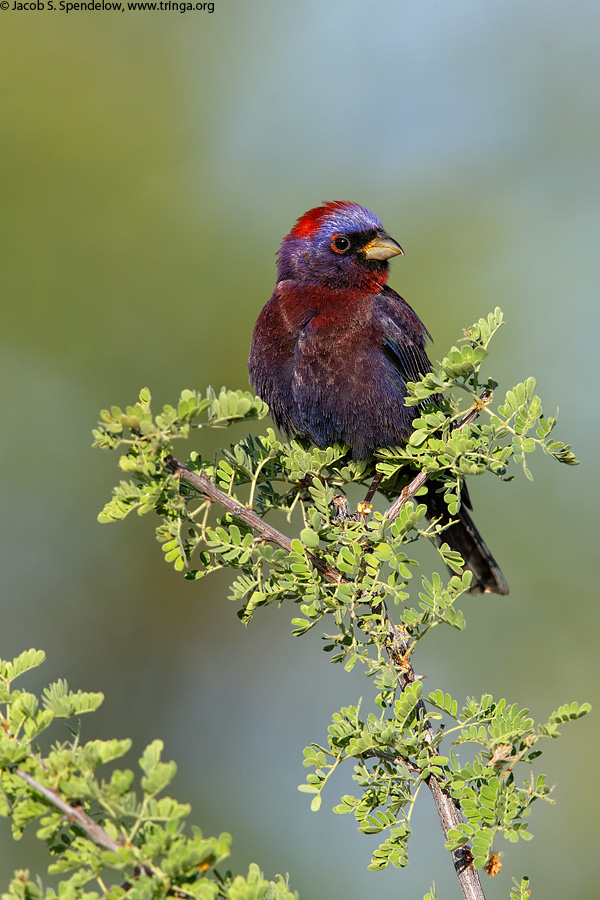
One of the most colorful birds of the Southwest, the Varied Bunting is an uncommon inhabitant of desert canyons and washes in Southeast Arizona.
Warblers are also a highlight of any spring birding trip to the Southwest. Though lacking the rich warbler diversity of the eastern forests, the mountains and canyons of the Southwest host a few species unique to the area, including the spectacular Red-faced Warbler. Perhaps the most common and ubiquitous warbler in the southwestern forests is the Grace's Warbler, which can be heard singing in just about any patch of conifers above 7000 feet.
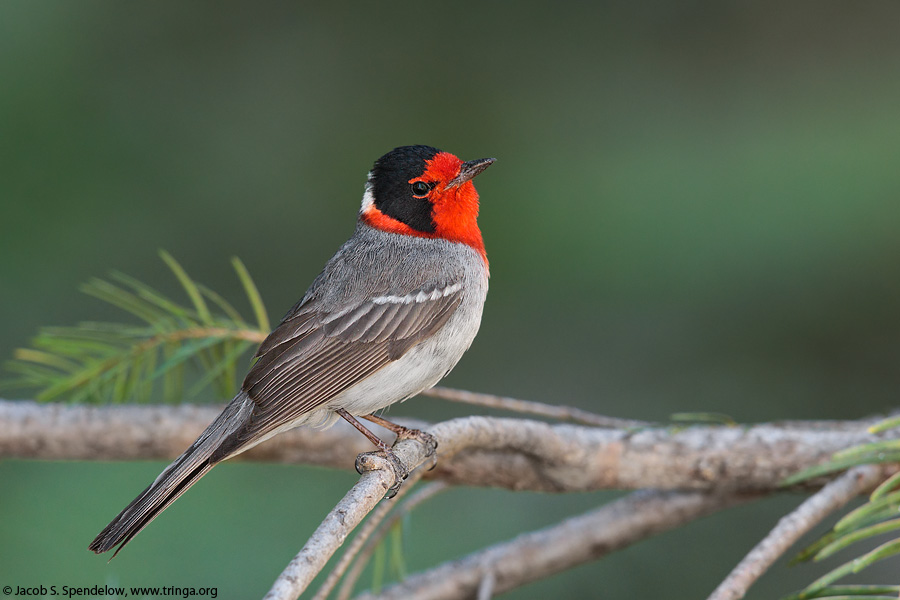
A Red-faced Warbler in the Santa Catalina Mountains.
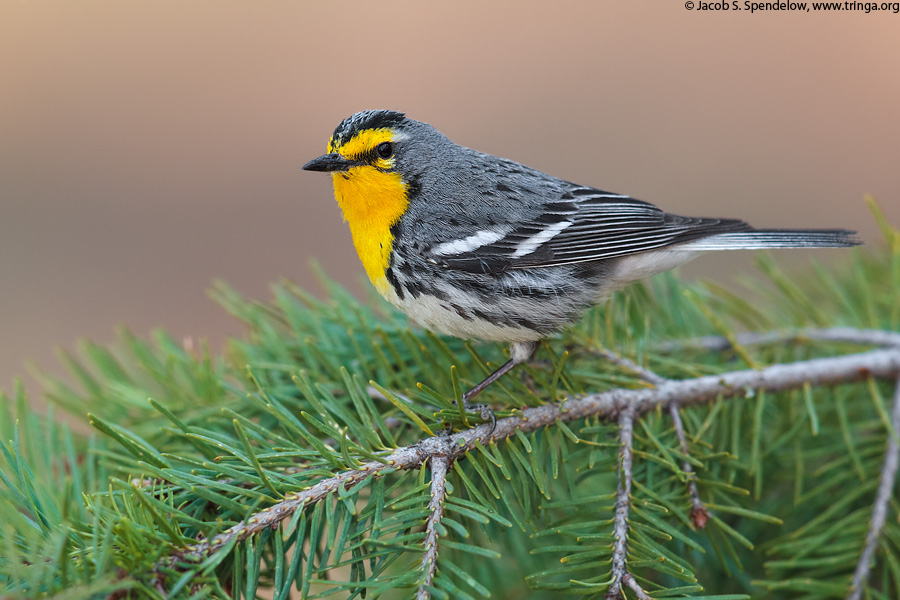
I photographed this Grace's Warbler in the Black Range of New Mexico while en route to Arizona.
The biggest draw for most birders to the area is the spectacular array of hummingbirds found in the sky islands of Southeastern Arizona. For birders coming from east of the Mississippi, who make do with only a single species of hummingbird at home, the ten or more hummingbird species commonly found in Arizona provide endless entertainment. Hanging out in the shade by a well-stocked hummingbird feeder is a great way to spend a hot Arizona afternoon, and the feeders at hotspots like Ramsey Canyon draw thousands of birders every year. August is the best time for hummingbirds in that area, but several species are already common in May, including my two personal favorites, the jewel-like Broad-billed Hummingbird and the aptly named Magnificent Hummingbird.
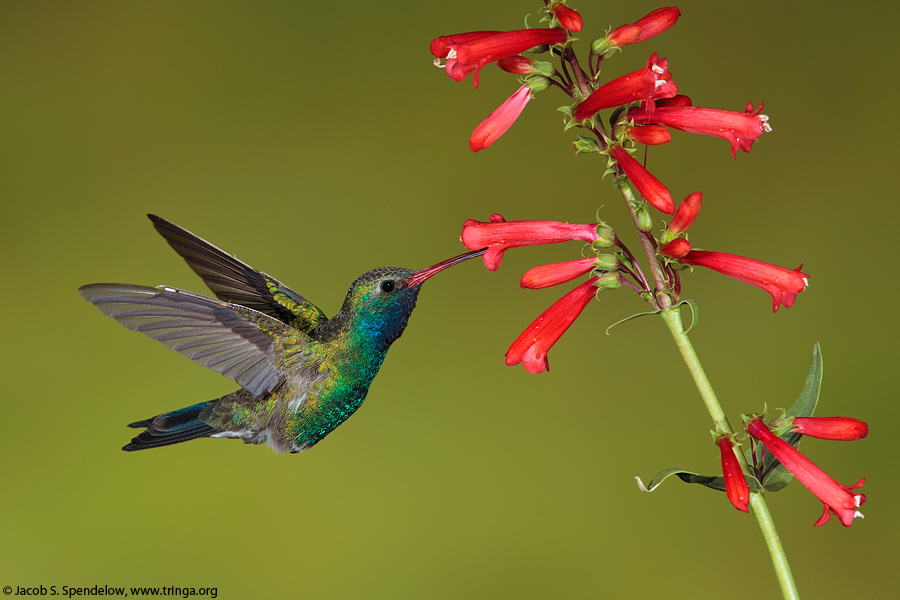
A Broad-billed Hummingbird sipping nectar from a Firecracker Penstemon. This individual is missing the outermost primary feather on his right wing.
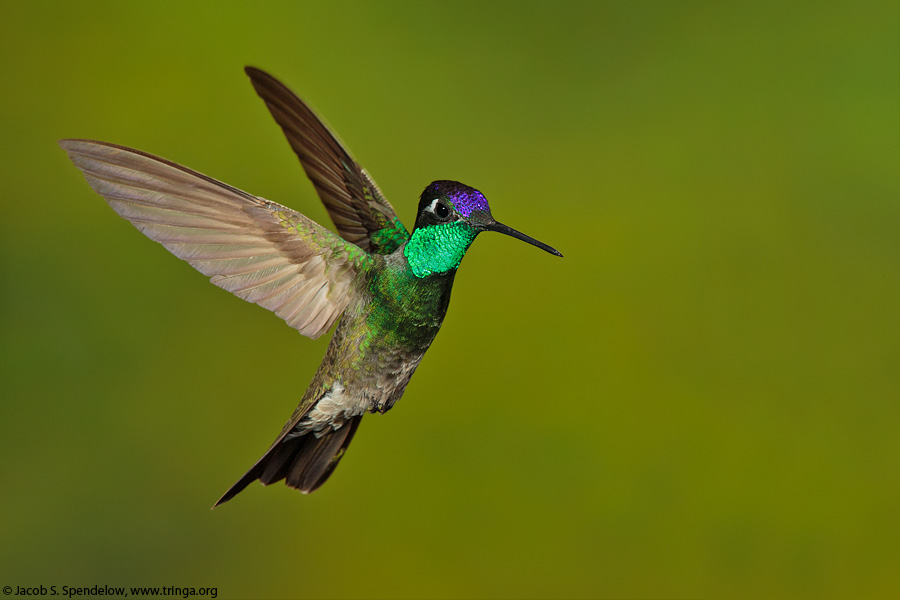
The Magnificent Hummingbird is a large and aggressive hummingbird primarily found in the higher elevations of the Madrean Sky Islands, with smaller populations present in other nearby mountain ranges of Arizona and New Mexico. In this region, only the Blue-throated Hummingbird is larger.
Night birding can be similarly productive, with far more species of owls and nightjars present in Southeast Arizona than in any other part of the country. I enjoyed spending many a late night and early morning searching for Whiskered Screech-Owls, Mexican Whip-poor-wills, and other night birds. Even during the day time, Arizona provides great owling. I was thrilled to photograph both a roosting Spotted Owl and a nesting Northern Pygmy-Owl during my time in Arizona.
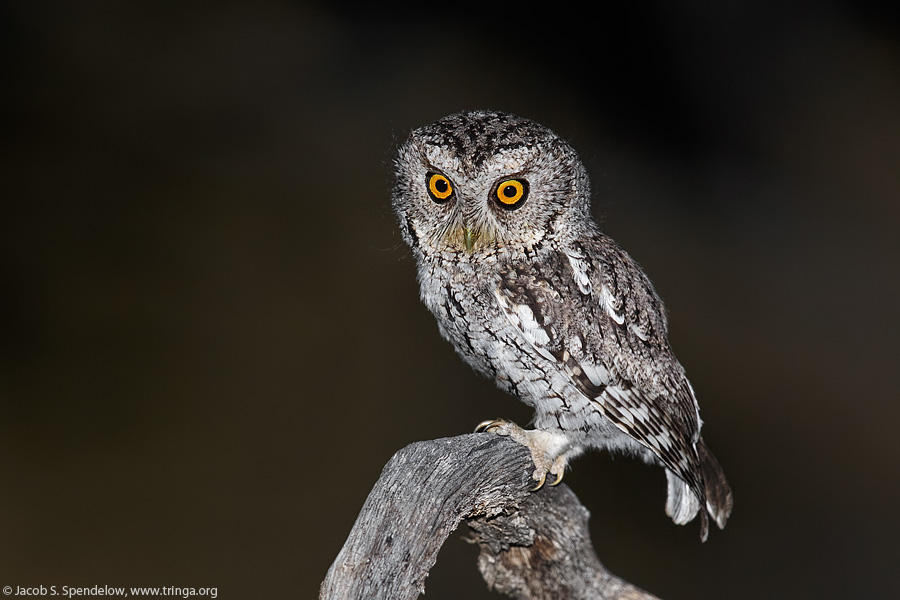
Whiskered Screech-Owls are common in the Madrean Sky Islands, where they are typically found in mid-elevation and upper-elevation forests. At lower elevations they are largely replaced by Western Screech-Owls.
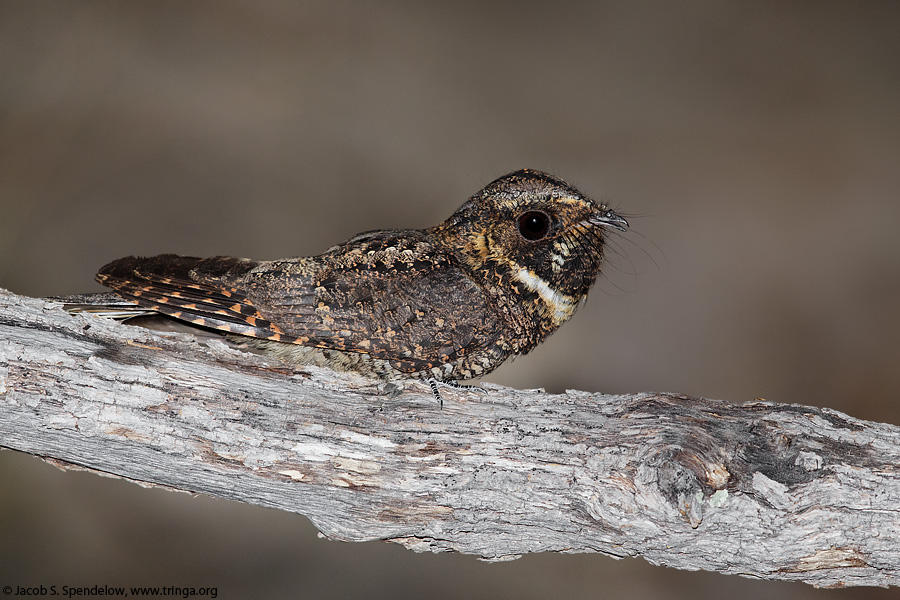
A Mexican Whip-poor-will in the Santa Catalina Mountains. Though similar in appearance to the Eastern Whip-poor-will, from which it was recently split, identification is not usually a problem, since the ranges of these two species are separated by hundreds of miles.
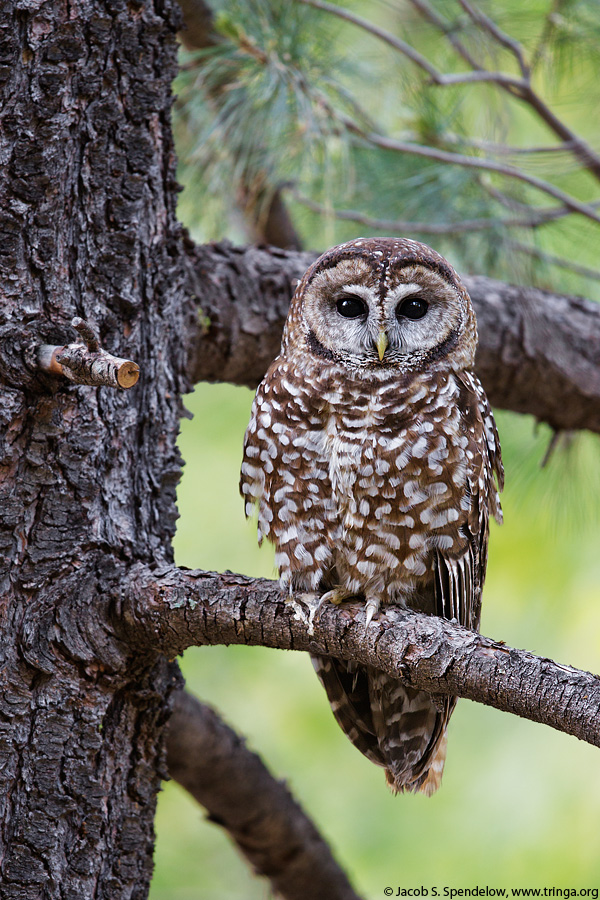
This Spotted Owl is a member of the Mexican subspecies, a scarce resident of the Madrean Sky Islands and other mountain ranges of the southwest.
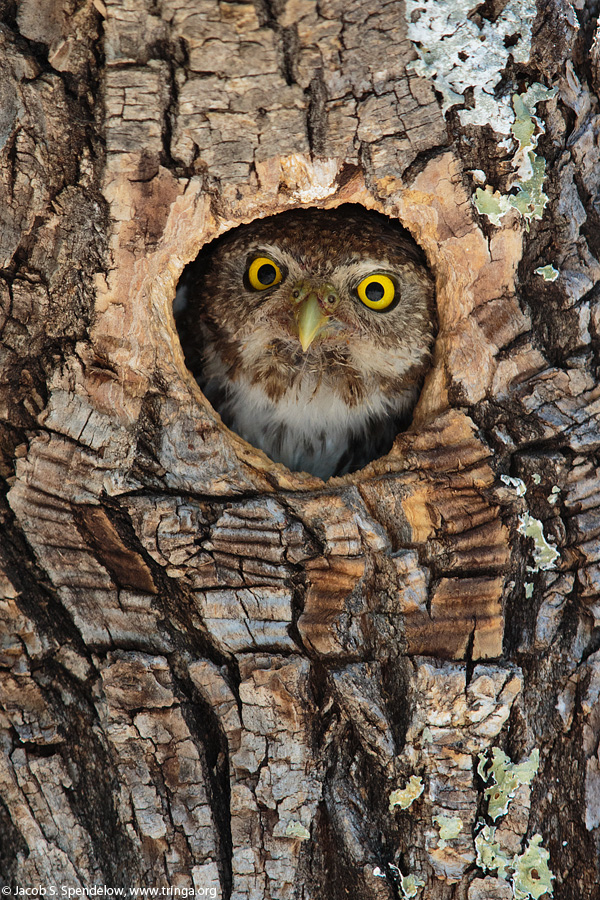
A Northern Pygmy-Owl prepares to exit a nest hole. Unusual for owls, this species remains active throughout the daylight hours. This photo was taken in early afternoon.
I left the Southwest to head back to Virginia in early June, but took the long way home to explore a few new areas and try to chase down a few more of my most-wanted birds. I started with a couple days in the Pawnee Grasslands of Colorado, where longspurs were my main target. I was happy to get some decent photos of McCown's Longspur, but will have to wait till my next trip to try again for Chestnut-collared. The wide-open short grass prairie was a sight to behold, especially on my second night on the grasslands, when a beautiful sunset played out over the prairie.
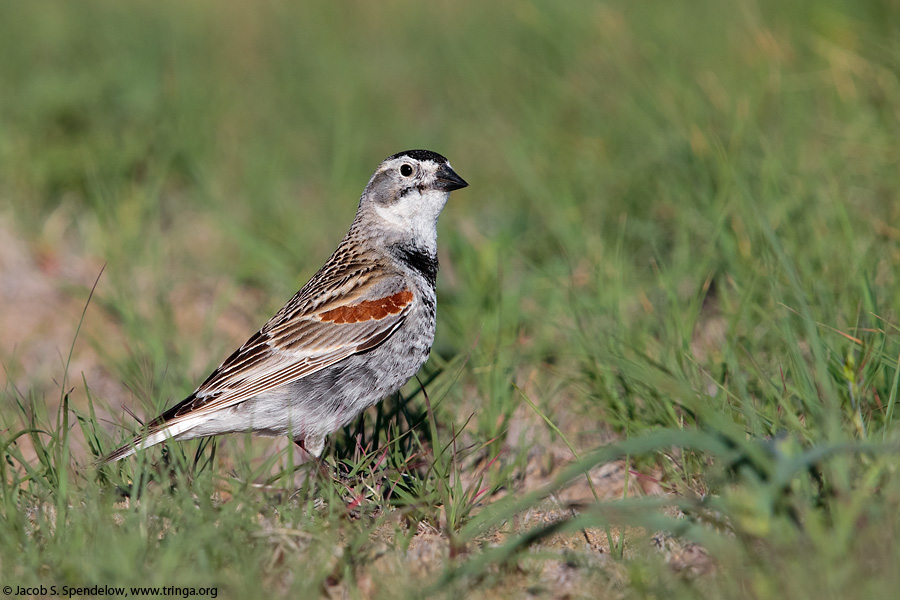
A McCown's Longspur in the Pawnee Grasslands.
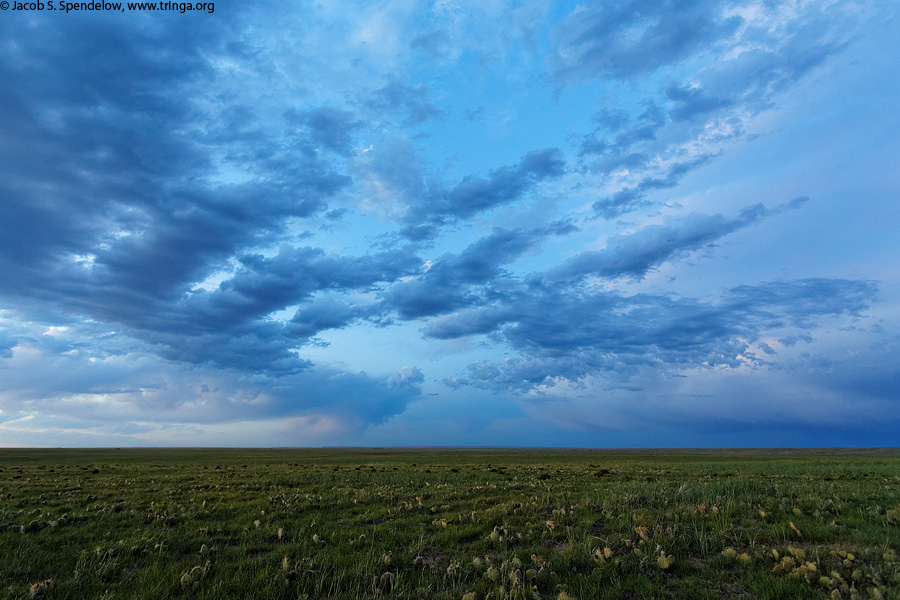
Dusk on the Pawnee Grasslands.
Next I headed east to Nebraska, where I enjoyed a beautiful morning photographing in the grasslands near the North Platte River. Dickcissels are abundant in those parts, and they aren't shy. I also found a gorgeous Western Meadowlark singing his heart out that morning. This was my first time in Nebraska, and my expectations weren't particularly high going in, but that one magical morning has me thinking about a return trip some day.
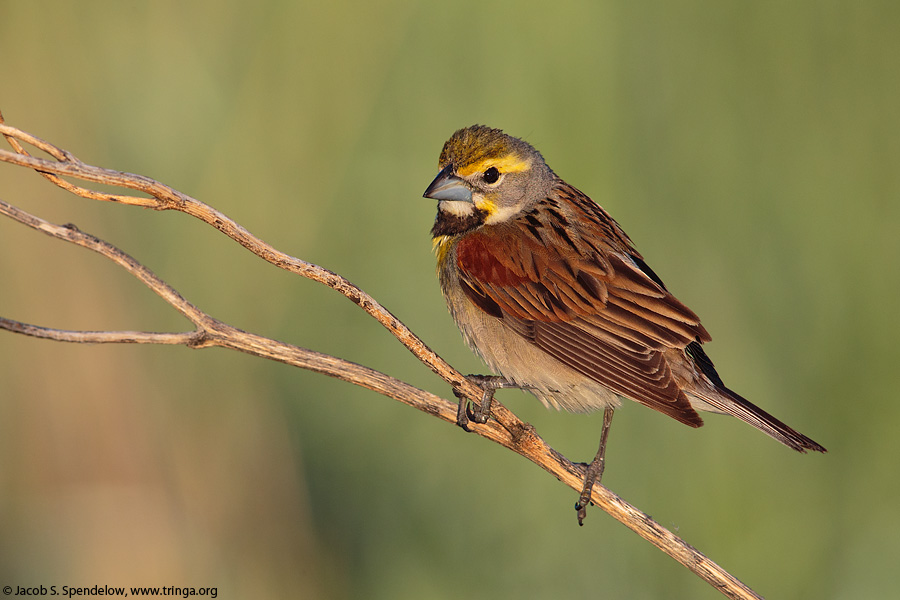
A Dickcissel on a sunflower stalk in grasslands near the North Platte River. This beautiful prairie-dweller has no close living relatives, and its taxonomic placement has shifted through the years. It is now considered to be related to cardinals and passerina buntings.
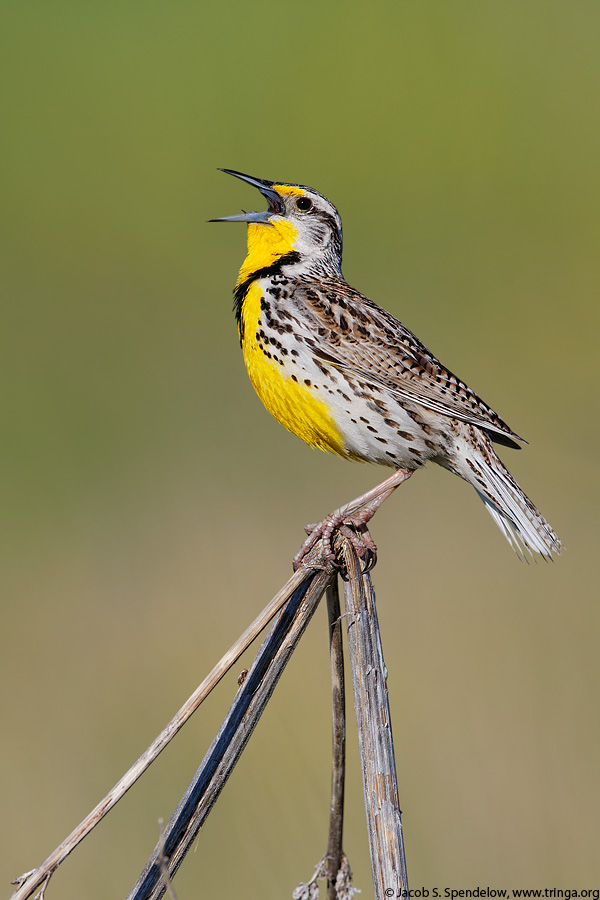
A Western Meadowlark defends his territory on a beautiful morning in Nebraska. Though similar to the Eastern Meadowlark, which is also found in Nebraska, the Western can be readily distinguished by voice, as well as by the yellow malar area and relatively pale brown crown.
My original plan was to leave Nebraska early enough to make it to the forests of eastern Illinois in time for an evening shoot, but after lingering too long in the grasslands that morning, then getting stuck in construction traffic on I-80, it became clear that I wasn't going to make it. So I changed plans at the last minute, and detoured south to pass through Kansas with two targets in mind: Painted Bunting and Scissor-tailed Flycatcher, both of which reach the northernmost extent of their range in northern Kansas. I didn't find any of the flycatchers, but the Painted Buntings more than compensated for that. I spent a wonderful evening and the next morning photographing those rainbow-colored birds in sweet light on the juniper-covered hillsides near Topeka. I heard plenty of Dickcissels and Eastern Meadowlarks singing in the nearby grasslands, but I had run out of time on my trip, and had to get on back to Virginia, which I did without any further photo stops.
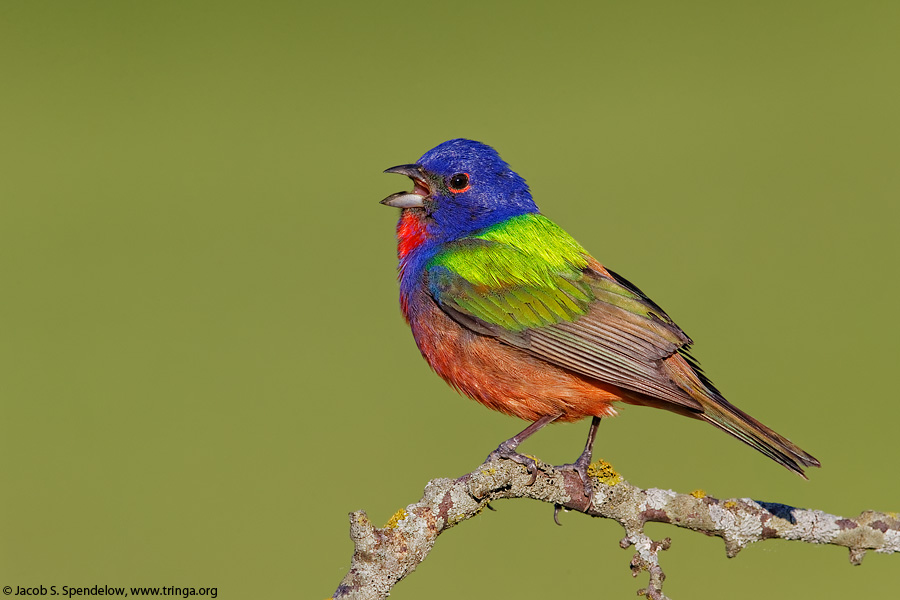
Easily the most colorful bird in North America, the Painted Bunting seems to have every color on an artist's palette.
Despite living there for three years, the southwest represented the biggest gap in my bird photo catalog prior to this trip. With so many species unique to that area, I knew that I would need a good long trip to cover most of them, so I was glad to finally get to do that this spring. Looking forward to improving on these photos and adding photos of some of the rarer specialties on my next southwestern trip. I'm sure I'll make many more trips to this distinctly beautiful part of the world.
March 5, 2013 - Minnesota and Ontario
Every four years, natural rodent population cycles prompt hungry northern owls to fly to the southern limits of the boreal forests and beyond in search of food. The biggest owl invasion on record occurred in 2005, a year in which many birders (including me) saw Great Gray, Northern Hawk, and Boreal Owls for the first time. Much to the delight of birders and photographers alike, another owl invasion occurred this winter, with several Great Gray and Northern Hawk Owls appearing in Southern Ontario and Northern Minnesota in January, and a remarkable movement of Boreal Owls into Minnesota that peaked in early February.
I spent the first weekend in February in Ontario, where I enjoyed some fantastic weather and incredible photo ops with several Great Gray Owls. The snow flurries that persisted for most of the morning on both Saturday and Sunday created ideal conditions to photograph these mysterious and majestic birds - I just love the way those piercing yellow eyes glare out at me from a shroud of snowflakes.
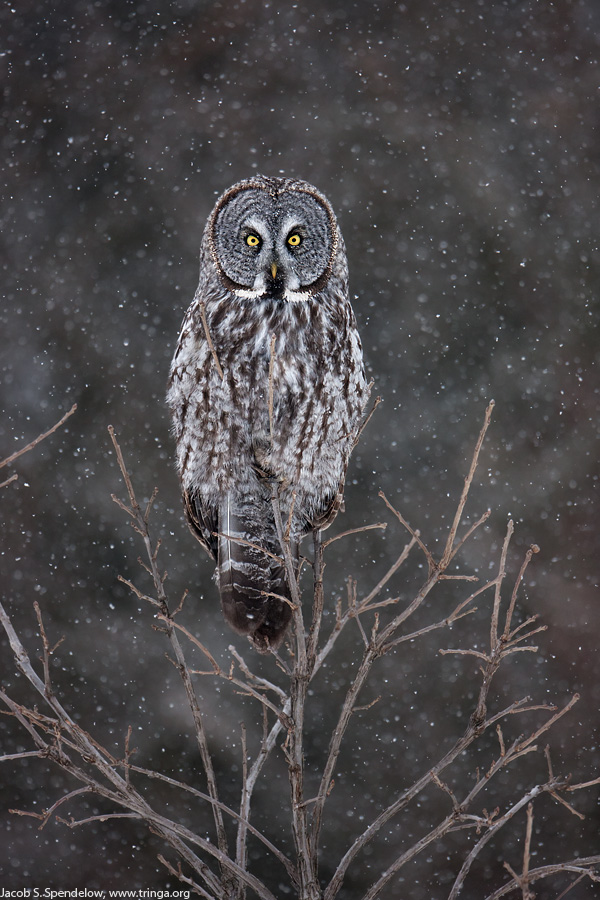
One of several Great Gray Owls that invaded southern Ontario this winter. I was well dressed for the cold, but nothing could keep those piercing yellow eyes from making me shiver!
Right around the time I was in Ontario, reports of birders seeing as many as seven Boreal Owls in a day started coming in from Minnesota. Finding some last minute airfare that was too cheap to pass up, I canceled my plans for a second Ontario trip and instead headed to Minnesota for four days of searching for Boreal Owls and other northern specialties along the north shore of Lake Superior and in Sax-Zim Bog. The Boreal Owls proved harder to find than I'd expected from the reports - I searched for about eight hours before seeing my first one in Two Harbors. But all the searching was well worth it for such a cool little owl, though he didn't really do anything but sleep. Returning again the next day, I found presumably the same individual after another lengthy search, but this time it was more like he found me - he flew up and landed in a tree across the road just as I was giving up and getting into my car. What a treat it was to get to see this elusive owl actively hunting on a light overcast day. I followed him around from a respectful distance for the rest of the day, sometimes waiting up to two hours while he napped, and got to see him make seven flights. Sadly, he didn't catch anything at all. I hope he did better after nightfall - he must have been very hungry to be hunting so much during the day.
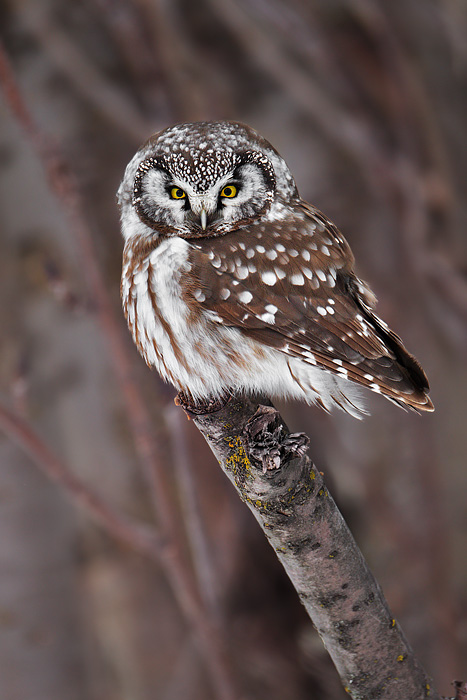
An actively hunting Boreal Owl in early afternoon.
Owls weren't the only birds invading this winter - winter finches were also present in abundance in Minnesota, and I enjoyed getting photos of numerous Hoary Redpolls, which are always a favorite. I was happy to get some photos of Evening Grosbeaks as well. Though I have many photos of this species from the mountains of New Mexico, almost all of them were taken on clear sunny days, and in my opinion, directional light just can't do justice to the incredible plumage of this unusual finch. So it was great to get some photos in the incredibly soft light created by a combination of overcast skies and snow-covered ground.
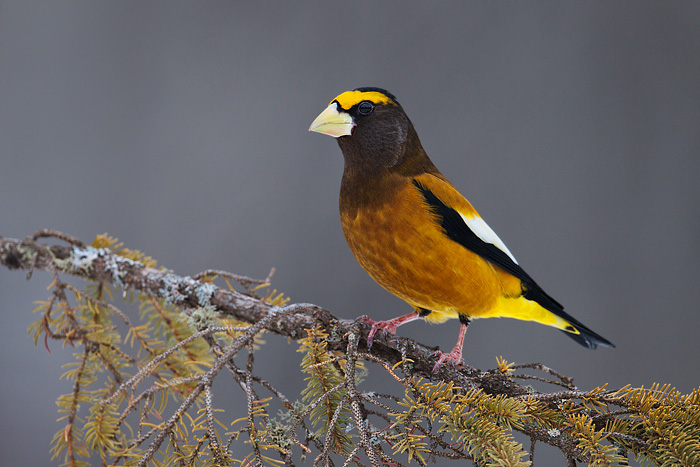
An Evening Grosbeak on a spruce branch. This irruptive finch is experiencing long-term population declines in the eastern part of its range, likely due to decreases in spruce budworm populations. However, Evening Grosbeaks remain more common in Eastern North America than they were in centuries past - reportedly, a gradual range expansion from west to east during the 19th and 20th centuries brought them into much of their current eastern range.
January 25, 2013 - Jan Wegener's New Site
I had a lot of fun designing my own website about a year ago, but after I was done, I found myself feeling a bit... bored? That's not quite the right word, since I always have a lot of stuff going on, but I missed the fun and intellectual stimulation of coding. So I was delighted and honored when German-Australian bird photographer extraordinaire Jan Wegener asked me to design a similar site for him. Jan and I have a similar aesthetic vision when it comes to both photography and design - we both gravitate towards the clean and uncluttered - so we were a good match for this project.
After getting the code mostly complete during the fall, my participation in the project has been on hold as Jan has been working on adding new images to the database. Jan still has a huge back catalog of images to add, but with over 1500 images uploaded, we decided to take the site live this week. Please check it out at vogelfotografien.de! Be sure especially to check out his parrot galleries, which comprise the most breathtaking collection of Australian parrot images on the web.
January 21, 2013 - West Coast
My latest update gallery contains images from two weeks on the west coast around the holidays. I started with six days of bird photography in California, then headed up to Portland to visit family for another six days, with a few photo sessions squeezed in.
My route through California was more or less one big circle - starting in LA, then northwest to western Kern County, east to eastern Kern County, southeast to San Bernardino County, further south to Imperial County, west to San Diego County, and then north for a final day in San Bernardino and Orange Counties. My top two targets were Le Conte's Thrasher and Nuttall's Woodpecker. Though neither is strictly endemic to California, both species are more common in California than anywhere else.
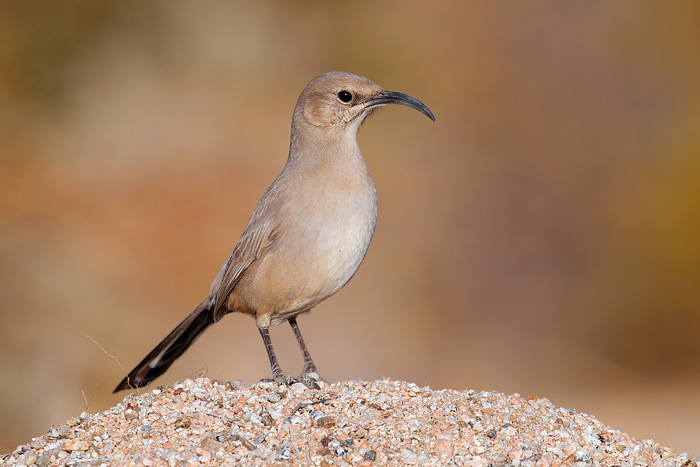
Le Conte's Thrasher is little known and seldom seen by most birders. The most typical sighting of a Le Conte's is a fleeting glimpse of a pale brown bird scurrying on foot across a dry wash.
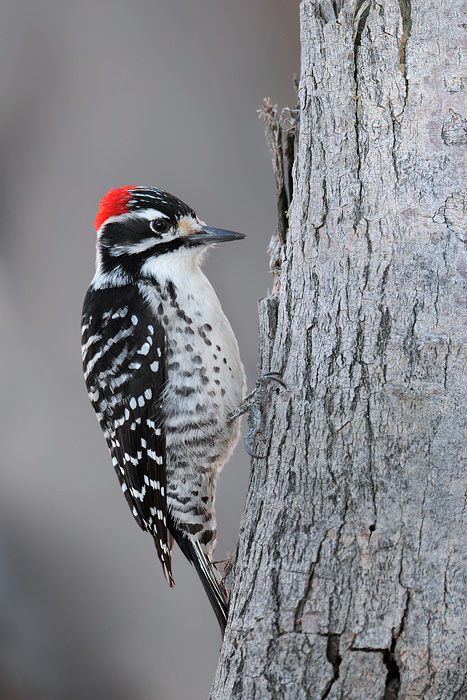
Nuttall's Woodpecker is a coastal and mountain-dwelling sister species to the Ladder-backed Woodpecker of the interior deserts (the two hybridize where their ranges overlap). The vast majority of Nuttall's Woodpeckers are found in California, with just a few in Nevada and Baja California.
Along the way I also got to photograph a few other good birds that had proven difficult on previous trips, including Abert's Towhee and Loggerhead Shrike. I was mostly focused on inland and desert birds, but I did spend a morning and an evening on the incredibly productive beaches of Southern California, where I got to photograph a variety of gulls, terns, and shorebirds.
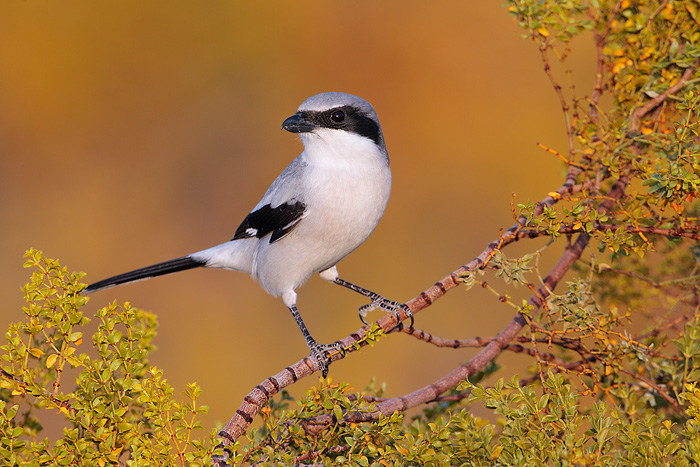
A Loggerhead Shrike on a creosote branch in the Mojave Desert.
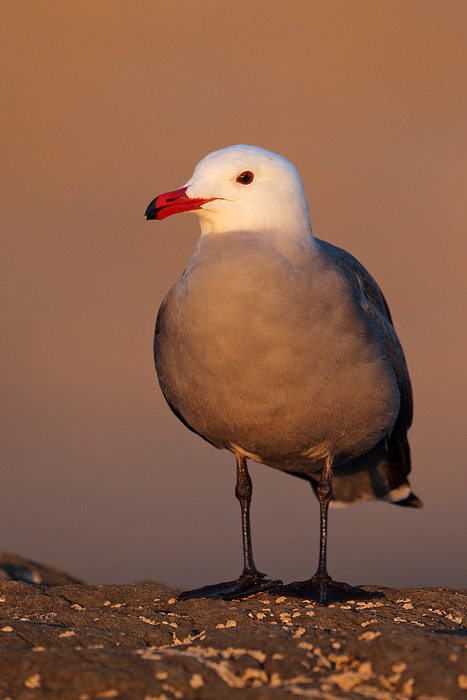
A Heermann's Gull at last light on a rocky beach in Orange County. The pure white head indicates that this bird is in at least its third winter.
While in Portland, I took a day trip up to Ocean Shores, Washington to photograph the Snowy Owls that invaded from the north this winter. At least eight owls were present, and they all looked beautiful on the driftwood of Damon Point. I only wish I'd had more than one afternoon with these gorgeous birds. Closer to home, I also made a few brief forays out to some of the local ponds to photograph waterfowl such as Cackling Goose and Gadwall.
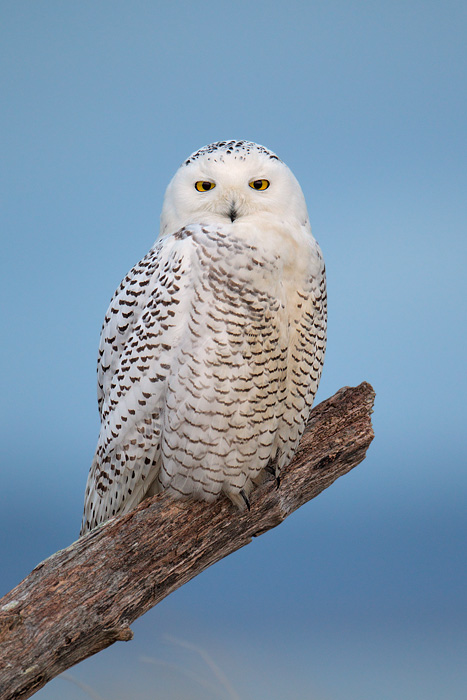
A Snowy Owl on driftwood at Damon Point. This is the second winter in a row that has seen a large invasion of Snowy Owls along the west coast.
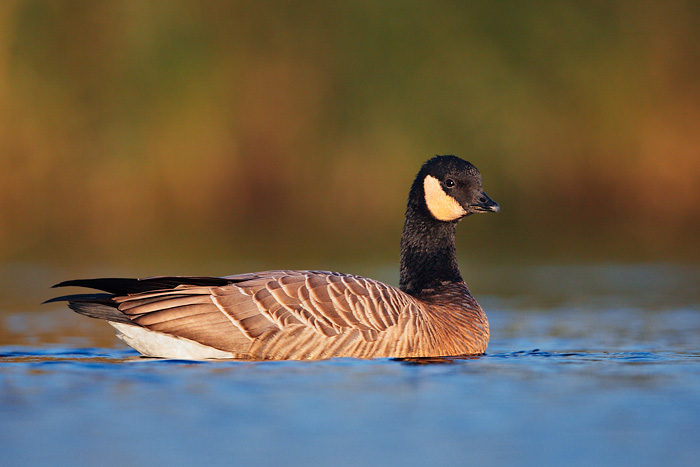
The tiny minima race of Cackling Goose is the easiest to identify, with its stubby bill and short neck distinguishing it from every race of the much larger Canada Goose.
I'm not sure what my next trip will be. With a variety of owls and finches invading southern Ontario and Quebec, I may head up north soon, but I don't like driving so far for just a weekend trip. In the meantime I've been contenting myself with a bit of local owling, including a brief encounter with an Eastern Screech-Owl last night.
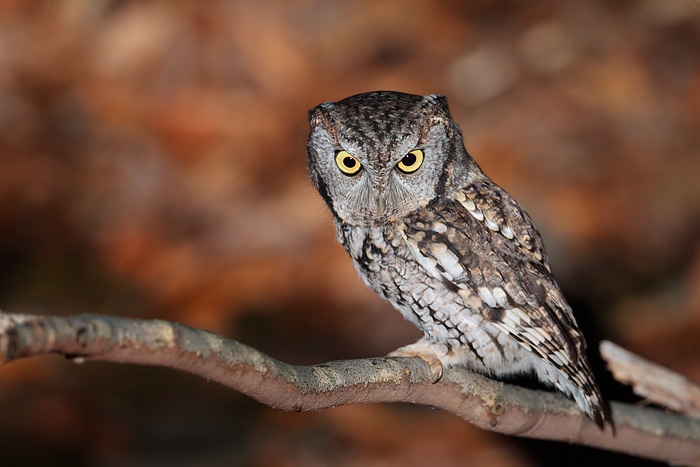
An Eastern Screech-Owl against a backdrop of dead leaves in the Bull Run Mountains of Virginia.